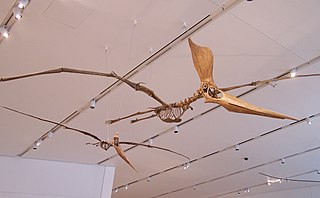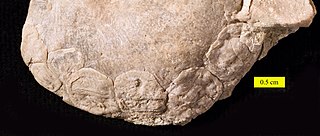
Pteranodon is a genus of pterosaur that included some of the largest known flying reptiles, with P. longiceps having a wingspan of over 6 m (20 ft). They lived during the late Cretaceous geological period of North America in present-day Kansas, Nebraska, Wyoming, South Dakota and Alabama. More fossil specimens of Pteranodon have been found than any other pterosaur, with about 1,200 specimens known to science, many of them well preserved with nearly complete skulls and articulated skeletons. It was an important part of the animal community in the Western Interior Seaway.

Septa are thin walls or partitions between the internal chambers (camerae) of the shell of a cephalopod, namely nautiloids or ammonoids.

Xiphactinus is an extinct genus of large predatory marine bony fish that lived during the late Albian to the late Maastrichtian. The genus grew up to 5–6 metres (16–20 ft) in length, and superficially resembled a gargantuan, fanged tarpon. It is a member of the extinct order Ichthyodectiformes, which represent close relatives of modern teleosts.

The UW–Madison Geology Museum (UWGM) is a geology and paleontology museum housed in Weeks Hall, in the southwest part of the University of Wisconsin–Madison campus. The museum's main undertakings are exhibits, outreach to the public, and research. It has the second highest attendance of any museum at the University of Wisconsin–Madison, exceeded only by the Chazen Museum of Art. The museum charges no admission.
Platecarpus is an extinct genus of aquatic lizards belonging to the mosasaur family, living around 84–81 million years ago during the middle Santonian to early Campanian, of the Late Cretaceous period. Fossils have been found in the United States and possible specimens in Belgium and Africa. A well-preserved specimen of Platecarpus shows that it fed on moderate-sized fish, and it has been hypothesized to have fed on squid, and ammonites as well. Like other mosasaurs, it was initially thought to have swum in an eel-like fashion, although another study suggests that it swam more like modern sharks. An exceptionally well-preserved specimen of P. tympaniticus known as LACM 128319 shows skin impressions, pigments around the nostrils, bronchial tubes, and the presence of a high-profile tail fluke, showing that it and other mosasaurs did not necessarily have an eel-like swimming method, but were more powerful, fast swimmers. It is held in the Natural History Museum of Los Angeles County. Isotopic analysis on teeth specimens has suggested that this genus and Clidastes may have entered freshwater occasionally, just like modern sea snakes.
Huronia is an actinocerid genus included in the Huroniidae along with Discoactinoceras and Huroniella,(Teichert 1964). Huronia is characterized by long siphuncle segments with the free part of the connecting rings only slightly inflated and by a narrow central canal and strongly curved radial canals located in the anterior part of each siphuncle segment

Pteranodon sternbergi is an extinct species of the pteranodontid pterodactyloid pterosaur genus Pteranodon from the Late Cretaceous geological period of North America. P. sternbergi was among the largest pterosaurs, with a wingspan of up to 6 metres (20 ft) in males. It has been argued that P. sternbergi should be classified in a separate genus, Geosternbergia, but this has not been followed by most other researchers.

The Craniidae are a family of brachiopods, the only surviving members of the subphylum Craniiformea. They are the only members of the order Craniida, the monotypic suborder Craniidina, and the superfamily Cranioidea; consequently, the latter two taxa are at present redundant and rarely used.There are three living genera within Craniidae: Neoancistrocrania, Novocrania, and Valdiviathyris. As adults, craniids either live freely on the ocean floor or, more commonly, cement themselves onto a hard object with all or part of the ventral valve.
Actinoceras is the principal and root genus of the Actinoceratidae, a major family in the Actinocerida, that lived during the Middle and Late Ordovician. It is an extinct genus of nautiloid cephalopod that thrived in the warm waters of the United States and England during the Paleozoic era.
Lambeoceras is a genus of large actinocerids with a convexly lenticular cross section from the Upper Ordovician of North America and the sole representative of the family Lambeoceratidae.

The Actinocerida are an order of generally straight, medium to large cephalopods that lived during the early and middle Paleozoic, distinguished by a siphuncle composed of expanded segments that extend into the adjacent chambers, in which deposits formed within contain a system of radial canals and a narrow space along the inner side of the connecting ring known as a paraspatium. Septal necks are generally short and cyrtochoanitic, some being recumbent, some hook shaped. Most grew to lengths of about 60 to 90 cm but some, like the Huroniidae of the Silurian grew significantly larger.
The Actinoceriatidae are a family of actinocerids named by Saemann in 1853 for those that grew to have large shells with blunt apices and large siphuncles with widely expanded segments and a generally arcuate endosiphucular canal system. Their range is from the upper Middle Ordovician to the Lower Silurian. Actinocerids are generally straight-shelled nautiloid cephalopods with a siphuncle composed of expanded segments, typically with thin connecting rings, in which the internal deposits are penetrated by a system of canals

The Armenoceratidae are a family of early Paleozoic nautiloid cephalopods belonging to the order Actinocerida.
Wutinoceras is a genus of now extinct nautiloid cephalopods of the Wutinoceratidae family. It exhibits orthoconic actinocerids with ventral siphuncles composed of broadly expanded segments.
Saffordoceras is an actinoceratid from the Middle Ordovician, found in eastern North America, characterized by a flattened venter; sutures with broad, deep ventral lobes and narrow lateral saddles; and subventral siphuncle with segments decreasing from about 0.3 to less than 0.2 the shell diameter. Saffordoceras is probably derived from Actinoceras. Related contemporary genera include Paractinoceras and Troostoceras

Dawndraco is a controversial genus of pteranodontid pterosaur from the Late Cretaceous of North America. It is likely synonymous with the contemporary pteranodontid Geosternbergia.
Kochoceras is an extinct nautiloid genus from the later Ordovician belonging to the family Actinoceratidae and found in North America.
Actinomorpha is a genus of valcouroceratid, order Oncocerida, from the Middle Ordovician of central North America, named by Rousseau Flower, 1943. The shell is breviconic, short and laterally compressed; the venter more narrowly rounded than the dorsum, having the effect of a modest keel in horizontal orientation. The shell is gibbous adorally, such that the body chamber is widest well behind the aperture. The siphuncle is ventral, which could also be indicative of a horizontal orientation in life, with broad, slightly inflated segments and continuous, radial, actinosiphonate, deposits.
Leurorthoceras is a genus of flattened actinoceratids with a siphuncle narrower than in Actinoceras, segments of which tend to become longer in the mature parts of the phragmocone, the chambered part of the shell. This fossil is known from the Middle Ordovician of North America, Europe, and Siberia.
Troostoceras is a genus of actinoceratid nautiloids with a cyrtoconic shell, otherwise similar to Actinoceras. The shell is slightly endogastric, curved such that the under or ventral side is longitudinally concave, tucked in. The siphuncle is ventral and is in contact with the shell wall. Segments begin small but expand during growth.








